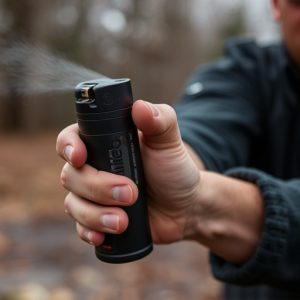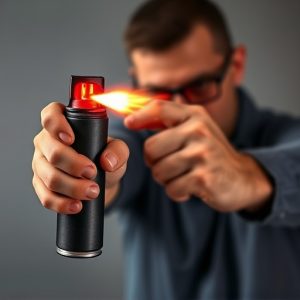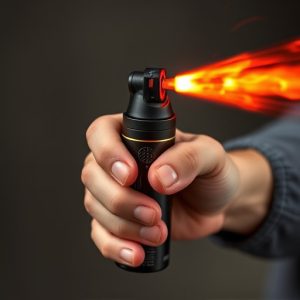Mastering Bear Spray Application: Safety, Efficacy, and Maintenance
Chemical irritants like bear spray are powerful personal protection tools that require understanding…….
Chemical irritants like bear spray are powerful personal protection tools that require understanding their action mechanisms and optimal application techniques. Key factors include distance, wind conditions, and proper usage of the sprayer for accurate deployment. Bear sprays, usually containing capsaicin or oleoresin capsicum (OC), should be applied at close range (2-3 feet) directly to the bear's face and eyes for maximum effectiveness. Best practices involve regular training, inspection, and maintenance of the device. The ideal application technique is aiming for the eyes and face in a 20-35 foot range, using smooth, steady motions with liberal coverage. Proper upkeep ensures optimal performance and safety during encounters.
“Personal protection against bear attacks is an essential consideration for outdoor enthusiasts in bear country. Chemical irritants, particularly bear spray, have emerged as game-changers in this domain. This article explores the critical role of chemical irritants in personal safety devices, focusing on bear spray. We’ll delve into the science behind these irritants, dissect different types, and uncover the best application techniques for maximum protection. Additionally, we provide guidance on maintenance to ensure your bear spray remains effective.”
- Understanding Chemical Irritants and Their Role in Personal Protection
- Types of Bear Sprays: Active Ingredients and Efficacy
- Best Practices for Bear Spray Application: Safety First
- Effective Spraying Techniques for Maximum Protection
- Maintenance and Lifespan of Your Bear Spray Device
Understanding Chemical Irritants and Their Role in Personal Protection
Chemical irritants play a crucial role in personal protection devices, offering an effective and non-lethal means of deterring potential threats. These substances are designed to cause discomfort or irritation when come into contact with the eyes, skin, or respiratory system, allowing individuals to create distance from dangerous situations. Bear spray, for instance, is a popular choice for outdoor enthusiasts and those living in areas with bear populations. Understanding how these irritants work is essential for optimal protection.
When using personal protection devices like bear spray, knowledge of the best application techniques is vital. This includes recognizing the appropriate range for application, understanding wind conditions, and knowing how to operate the sprayer effectively. By mastering these skills, individuals can ensure that they deploy the irritant accurately and safely, maximizing its effectiveness in deterring and repelling potential attackers.
Types of Bear Sprays: Active Ingredients and Efficacy
Bear sprays are a crucial component of personal protection devices for individuals venturing into bear country. When it comes to understanding the effectiveness of these sprays, knowing the active ingredients is key. The most common active ingredient in bear spray is capsaicin, derived from chili peppers. This ingredient creates an intense irritation in bears’ eyes and respiratory system, temporarily disorienting them and enabling a safe escape. Another popular option is oleoresin capsicum (OC), which is also highly effective against bears due to its similar chemical composition to capsaicin.
The best bear spray application techniques involve ensuring proper timing and distance. Spraying should be done at close range, typically within 2-3 feet, directly towards the face and eyes of the bear. The spray creates a cloud that envelops the bear, making it crucial to aim for maximum coverage. Proper usage involves a quick, burst-style application rather than a prolonged spray, as this maximizes the irritant’s impact while minimizing potential self-exposure to the spray.
Best Practices for Bear Spray Application: Safety First
When it comes to bear spray application, understanding best practices is crucial for safety and effectiveness. Before using any chemical irritant, ensure proper training and familiarize yourself with local regulations regarding wildlife interaction. Check your device regularly to confirm it’s in good working order, with a full canister and no signs of damage.
For optimal results, target the bear’s face—especially the eyes, nose, and mouth. Aim high, as spray can be blown back towards you. Keep an eye on the bear’s behavior; if it charges despite the spray, move to higher ground and call for backup. Remember, prevention is key; carry your spray openly when hiking in bear country, and make noise to avoid surprising bears.
Effective Spraying Techniques for Maximum Protection
To ensure maximum protection from chemical irritants, understanding and practicing the best bear spray application techniques is crucial. One effective method involves aiming for the eyes and face, as this area offers quick and significant disruption to an attacker’s senses. A fine mist or a single direct pulse of spray can temporarily blind and disorient an aggressor, providing valuable time to retreat or defend oneself.
The ideal range for application is between 20-35 feet (6-10 meters), where the spray can effectively cover the target area without becoming too diluted. It’s recommended to hold the can upright, slightly offset from the center of the intended target, and use a smooth, steady motion for consistent coverage. Remember, bear spray is designed to create a barrier of irritation, so applying it liberally across a wide area, rather than focusing on just one point, will enhance its effectiveness.
Maintenance and Lifespan of Your Bear Spray Device
Proper maintenance is key to ensuring your bear spray device serves its purpose when needed. Regular cleaning and inspection are vital, especially after each use. Remove any residual buildup or debris by gently spraying the nozzle in a safe area, following the manufacturer’s guidelines for best bear spray application techniques. Check for any signs of damage or wear, particularly on the canisters and trigger mechanism. Keep your device out of extreme temperatures and direct sunlight to prevent corrosion.
Replace parts if necessary and ensure the device is properly charged. Storing it in a cool, dry place will extend its lifespan. Remember, regular upkeep not only guarantees optimal performance but also enhances safety. By taking care of your bear spray, you can rely on it as a reliable personal protection measure against potential bear encounters.
When it comes to the best bear spray application techniques, understanding chemical irritants and their role in personal protection is key. By knowing the active ingredients in various bear sprays and practicing effective spraying techniques, you can maximize your safety in potential encounters. Remember, proper maintenance of your bear spray device is equally important to ensure its longevity and reliability when you need it most. Embrace these practices to become a more prepared and informed outdoor enthusiast.


